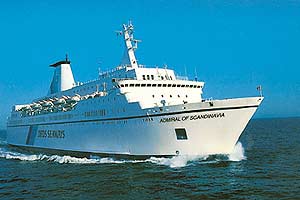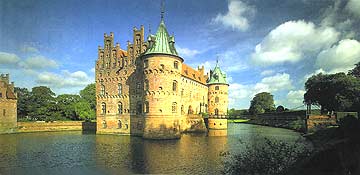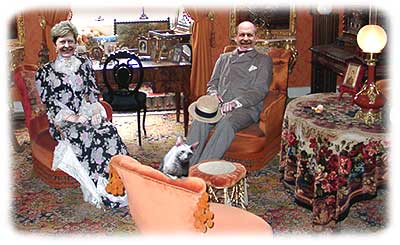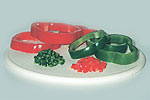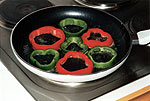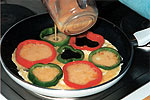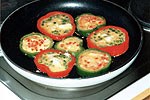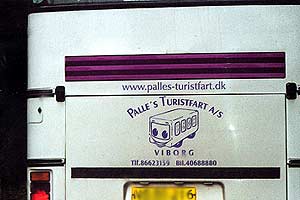by Dave DeWitt, Research and Notes by Mary Jane Wilan
|
Why Europe is Embracing Fiery-Foods Part Two: Germany and Denmark Part One Part Three
|
Recipes: Gravlax with Spicy Mustard Sauce Renate’s Mixed Pepper Medallions
|
We boarded the ferry Admiral of Scandinavia and the first thing Mary Jane did was upgrade our cabin to a better one. Actually, the word “ferry” is somewhat misleading because, although it does carry vehicles, the accommodations aboard the Admiral were rather plush–much better than the cruise ship Tropicale that we sailed on in the Caribbean. And the food was terrific–but not fiery at all.
|
|
Admiral of Scandanavia Ferry
|
We opted for the smorgasbord even though it cost 22 Euros for each of us (a Euro was worth a U.S. dollar at the time). Mary Jane ate quite a variety of foods, but I concentrated on the fish, selecting from about 25 different seafood dishes. The salmon was particularly fine, and I persuaded Mary Jane to try the gravlax, raw fillets that are cured in sugar, salt, and spices and served with a mustard sauce. She loved it, and we vowed to find a recipe. There wasn’t much to do aboard the ferry, so after a visit to the bar, we went to our cabin, watched BBC-TV, and fell asleep. The next morning, we were docking at the port of Cuxhaven, Germany.
Beaches and A Castle
We were picked up by Harald and Renate Zoschke, our friends who formerly owned the Peppers on the Pier hot shop in St. Petersburg, Florida. They have since returned to Germany to lead the fiery-foods revolution there with their German language web shop at www.pepperworld.com. They would be the perfect guides on our adventure to find hot stuff in northern Europe.
First the Zoschkes gave us a quick tour of downtown Hamburg. An outdoor food fair was in progress and we were able to sample food from all over Germany. The country is only about the size of Texas, but there were a surprisingly large number of regional cuisines to try. The number of different specialties made a national food fair seem like an international one.
From Hamburg, our friends drove us to their home base of the beachfront community of Schoenberg on the Baltic Sea. They live about 200 feet from the beach, and one of the treats of the beach is Kruse’s Räucherfisch (Kruse’s Smoked Fish), a market and restaurant right on the beach that serves fish caught and prepared by the fisherman himself, Hans Werner Kruse. There was quite a selection of fishy items on the menus–fish smoked, fried, and in sandwiches. I tried the herring, the salmon (again) and some excellent fried cod. One specialty the Germans have mastered is fried potatoes (not french fries, but home fries) and the ones at Kruse’s were superb.
The Zoschke’s next took us on a trip to the Danish island of Fyn (“Fünen” in German, pronounced “Fe-une,” or something like that.} The tourist brochure for the island proclaims it to be a “fairy-tale” place, and it was definitely scenic despite the rain and mist the first day we were there. Once again, the signs were baffling–even more so than in England. Particularly puzzling were the numerous signs proclaiming “Turist-Fart.” Now many places around the world resent tourists to a degree, but few post vulgar signs about them. I was getting irate when Harald patiently explained that in Danish, “fart” means “ride.” No wonder so many busses had that sign!
We checked into the Rødkilde Herregaard, a bed and breakfast in a huge old farmhouse, complete with its own water-driven grain mill. The farm surrounding it grew seed for golf course grasses–that was slightly amazing. For dinner we drove into Svendborg, the nearest town of any size and found a modest restaurant where a waitress spoke some English. Guess what we ate? Poppy-seed encrusted sea trout with boiled new potatoes in butter and parsley. In fact, after I found out how big the sea trout grow up there–3 feet long–I wanted to go fishing, but we didn’t have time–rats.
|
|
Rodkilde Bed and Breakfast
|
The next day began with the breakfast part of a B&B, and we were served that fantastic Prima Donna cheese, soft-boiled eggs, paté, and freshly baked bread with black currant jam. Then it was castle time.
Egeskov Castle has been continuously occupied since it was built in 1552 and sits on an estate of about 2500 acres. Since all 66 rooms are not needed by the Ahlefeldt-Laurvig-Bille family, many of them are on display to the general public. Of particular interest were the Hunting Gallery, consisting of the trophy heads and pelts of game animals killed at a time when the number of impalas, elephants, and Cape buffalos was considered infinite, and the Victorian Room, furnished in the style of the era. The castle still has a moat! Well, a partial moat, anyway.
|
|
Egeskov Castle
|
I found the gardens even more interesting than the castle itself. There are four elaborate mazes, topiary in the shape of animals, a fuchsia garden with 104 species (some of the plants are 80 years old), a very large and beautifully designed vegetable garden (no chiles), and a large herb and dahlia garden. We ate lunch at the Café Jomfru Rigborg and–surprise–didn’t eat fish but rather roast beef with a pungent horseradish sauce. I made plans to send the castle gardening staff some chile pepper seeds.
|
|
Mary Jane, Dave, and Roz
|
The only hot and spicy foods we found in Denmark were taco sauces and salsas in supermarkets. We saw the Santa Maria brand from Sweden, the only Scandinavian country that is seriously advanced in fiery-foods.
Curry-Wurst, Santa Fe in Kiel, and the Future of Heat in Germany
We returned to Schoenberg, and the Zoschkes fed us smoked salmon, straw-smoked cheese, and Greenland shrimp with remoulade sauce. Very tasty, but I was ready for more meat–namely German pork and sausage. So, the next day we went to Kiel, checked out the German language cookbooks in the Borders-like bookstore in the mall, and then checked into the Kieler Brauerei (Kiel Brewery), where the beer is served in wooden kegs; that is, if you can drink 10 liters! That amount costs 65 Euros. We decided on the Hot Brewer’s Plate for Four, and the waitress brought out this gigantic metal platter of meats and sauerkraut that she placed on a rack with large, burning candles to keep it hot. This meal consisted of grilled ham, smoked pork, meat loaf (a processed meat unlike American meat loaf), various sausages including bratwurst, fried potatoes (as good or better than Kruse’s–I had four helpings), and sauerkraut that was the best I’ve ever tasted. According to Renate, the key to great sauerkraut is to add pineapple to it, and I suspect that was the secret ingredient at Kieler Brauerei.
|
|
Logo of the Kiel Brewery on a coaster
|
One of the most unique German food items Harald & Renate served us at their house were the Sündenbüsser (“sin repenter”) sausages. They are salami-style smoked sausages in mild, hot, and unbearably hot varieties.
|
|
Fiery-hot and tasty: Sündenbüsser sausages
|
Our meaty encounters continued the next day during a festival on the beach celebrating the anniversary of the Schoenberg pier. We sat at benches listening to the German band playing American rock and roll and tried curry-wurst. This is the most popular fast food in Germany, and I was prepared to dislike it since it was bratwurst slathered in ketchup to which curry powder had been added–and I’d been brought up believing that mustard went on sausages and hot dogs and ketchup went on hamburgers. (In Germany, of course, a Hamburger is not a sandwich but rather a person who lives in Hamburg. Likewise with a Frankfurter.) Anyway, the curry-wurst was excellent. Here’s how to make one: grill a brat. Mix ½ teaspoon of curry powder in 1 cup of ketchup. Cut the brat into 1″-size chunks, slather with the ketchup mixture, and chow down.
One of the weirdest experiences we had in Germany was dining at the Santa Fe Restaurant in Kiel. First, it looked like Santa Fe–the furniture, fixtures, and artwork were authentic. Harald told me that the owner had shipped everything from New Mexico. Second, the menu looked reasonably authentic. There were nachos, tacos, enchiladas, fajitas, burritos, salsa, guacamole, and margaritas. However, also on the menu were baby back ribs, Mexican pizza, tuna steak, chicken wings, California noodles, and bagels. Bagels? Don’t ask–we have green chile bagels in New Mexico, so there. The salsas and the guacamole were pretty good, but with just a hint of chile. The nachos were also okay, but rather bland. The menu states that all food is prepared for “normal” tastebuds, but chile fans can order their meals spiced up to “hot” or “superhot.”
Perhaps the best part of the meal was the green chile ice cream, which had a hint of heat. All in all, it was pretty good for being thousands of miles and a big ocean from Santa Fe.
|
|
MJ enviously looking
|
 |
But the restaurant symbolized major changes in the way Germans were eating. And my visit with Harald in his home office further brought home the point. In between restaurants, the Zoschkes were feeding us food spiced up with the products they carry in their web shop, so we didn’t suffer chile withdrawal. Harald and I were in front of his computer discussing hot and spicy topics–he is the webmaster of this site–when I heard what sounded like a telephone ringing. But Harald didn’t answer anything, he just kept talking. Then the ring came again. And again.
“What is that sound?” I asked.
“That is the sound of money,” he replied.
“Money?”
“Email orders coming in.”
And were they ever! And they were hot. Almost every order contained at least one bottle of the very hottest sauces they sell. Harald told me that his hottest products sold the best, and that many customers requested even hotter stuff. His company now has 3,000 German customers, and he gained those in less than two years. He is quoted in numerous magazine and newspaper articles, and his site has gotten enormous publicity. The first edition of his self-published book, Das Chili Pepper Buch, has sold out, and Harald just ordered a reprint. What is going on here? Actually, the answer is quite simple: the same thing that went on in the United States. The only difference is that Harald and Renate sell virtually no German products. Most are American, which are perceived as being more authentic. But in all other aspects, the trend toward fiery-foods is very similar: there are clubs, websites, restaurants, cookbooks, hotluck dinners, products imported from all over the world–and eager buyers.
“Fiery-foods are going to be very big here,” Harald predicted.
I agreed, listening to the ring of his orders flooding in. Renate was in her office, busily packing and shipping the orders.
|
|
Dave in Harald’s Greenhouse
|
The next day, on the way to the train station in Kiel, Mary Jane knew that Renate wanted a canister of pepper spray, so she gave her one as a going-away present. If we could have predicted what would happen in Amsterdam, we would have given her both canisters.
Resources:
Kruse’s Räucherfisch: www.fischer-kruse.de
Island of Fyn: www.visitfyn.com
Egeskov Castle: www.egeskov.com
Fishing in Fyn: www.seatrout.dk
Santa Fe Restaurant: www.santa-fe.de
Sündenbüsser Sauge: www.suendenbuesser.de
Recipes
Gravlax with Spicy Mustard Sauce
This Swedish dish takes two days to make, but it’s well worth the effort. After curing, the gravlax is sliced as thinly as possible, placed on black bread, and served with a little of the mustard sauce spread over it.
-
1/4 cup sugar
-
1/3 cup kosher salt
-
2 teaspoons coarsely ground black pepper
-
2 small bunches dill, coarsely chopped
-
½ bunch chervil, chopped
-
1 bunch Italian parsley, chopped
-
1 bunch lemon balm, chopped
-
2 tablespoons prepared hot mustard (with chiles)
-
1 tablespoon mustard powder
-
2 tablespoons sugar
-
2 tablespoons white vinegar
-
4 tablespoons canola oil
-
2 tablespoons freshly chopped dill
-
2 salmon fillets, about 1 ½ pounds each
In a bowl, combine the sugar, salt, and pepper to make the sugar mixture. In another bowl, combine the dill, chervil, parsley, and lemon balm to make the herb mixture. In a third bowl combine the mustard, mustard powder, sugar, vinegar, oil, and dill to make the mustard sauce. Cover and refrigerate the mustard sauce.
Place 1 fillet skin side down in a shallow bowl. Sprinkle ½ the sugar mixture over the fillet, ½ of the herb mixture, the rest of the sugar mixture, and the rest of the herb mixture. Place the second fillet on top of the first, flesh to flesh, and wrap with plastic wrap. Place the wrapped fillets in a shallow pan and weigh them down with something heavy, like bricks covered in aluminum foil or a cast iron skillet. Refrigerate for 24 hours, then flip the fillets, weigh them down, and refrigerated for another 24 hours. Serve with the mustard sauce.
Yield: 12 or more servings
Heat Scale: Mild
Renate’s Mixed Pepper Medallions
One morning Renate surprised us with this interesting dish she invented for Harald’s Das Chili Pepper Buch. The idea for this recipe was born when the Zoschke’s brought a couple of pancake rings from the U.S. — here, sliced bell peppers serve as edible rings. This dish is ideal as either a light and speedy snack or as a visual highlight at a brunch buffet. Either way, your eyes will enjoy, too!
-
1 green and 1 red bell pepper
-
1 green and 1 red chile (Serrano, Jalapeno or other hot species)
-
4 eggs
-
1 dash of nutmeg
-
Hot Sauce (Melinda’s XXX for example)
-
Salt to taste
-
Vegetable oil or butter to fry
|
|
Wash bell peppers, cut off stems and carefully remove interiors including seeds. Cut peppers into 1/2″ rings. Wash chiles, remove stems, interiors, including seeds, and finely chop each color separately |
|
|
Scramble eggs and add spices, including a hearty dash of Belligerent Blaze Hot Sauce. Heat butter or oil in a large frying pan on medium heat and cook bell pepper rings for 2-3 Minutes. |
|
|
Carefully pour the scrambled eggs into the pepper rings; while pouring, press rings firmly to the pan bottom to prevent too much egg seeping out from under the rings. |
|
|
Sprinkle chopped peppers over the eggs while the matter still liquid — the green ones over red rings, and vice versa, and cook until eggs are firm. Serve hot, with fresh toast. |
Takes about 30 minutes to prepare. 2 servings. Heat scale depends on the type of peppers used, from mild to medium hot.
|
|
Somewhere in Denmark:
|
Photos by Dave DeWitt, Mary Jane Wilan and Harald & Renate Zoschke

